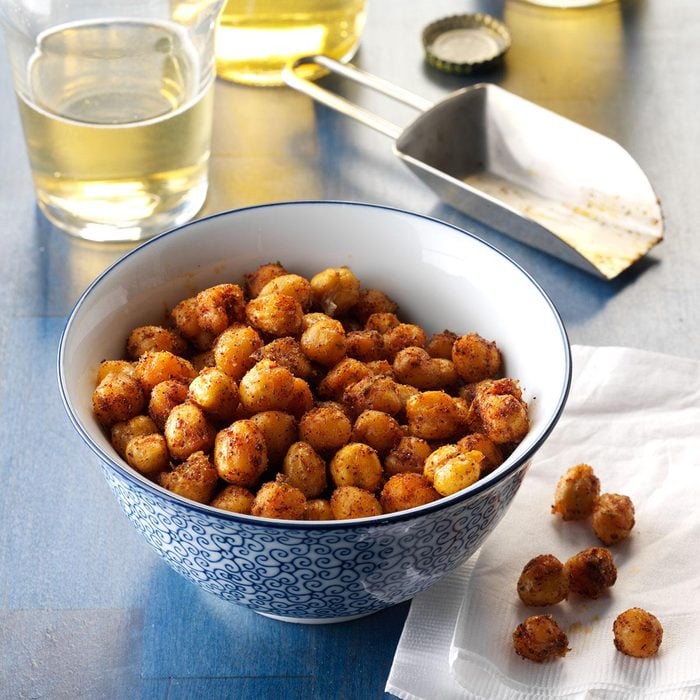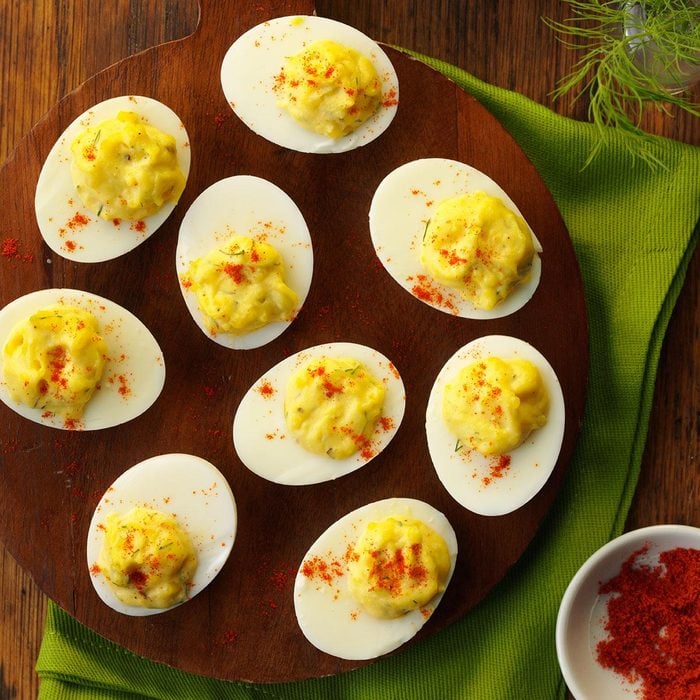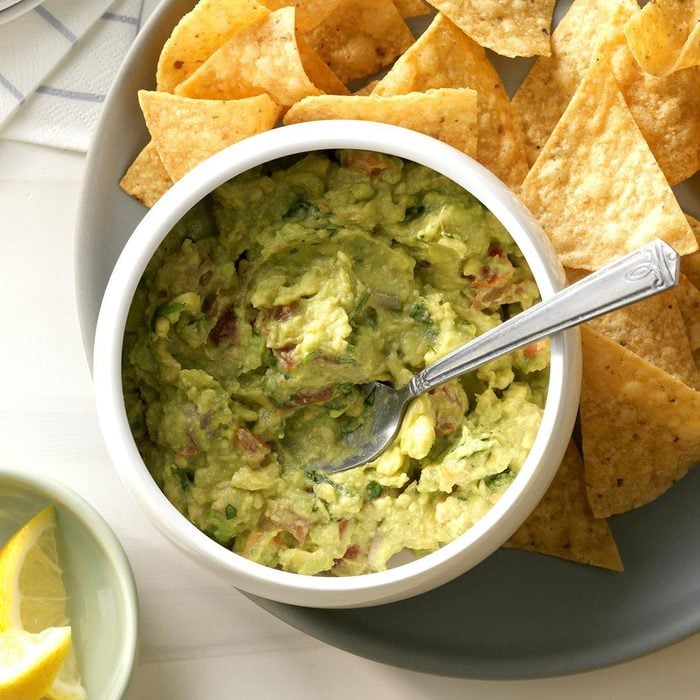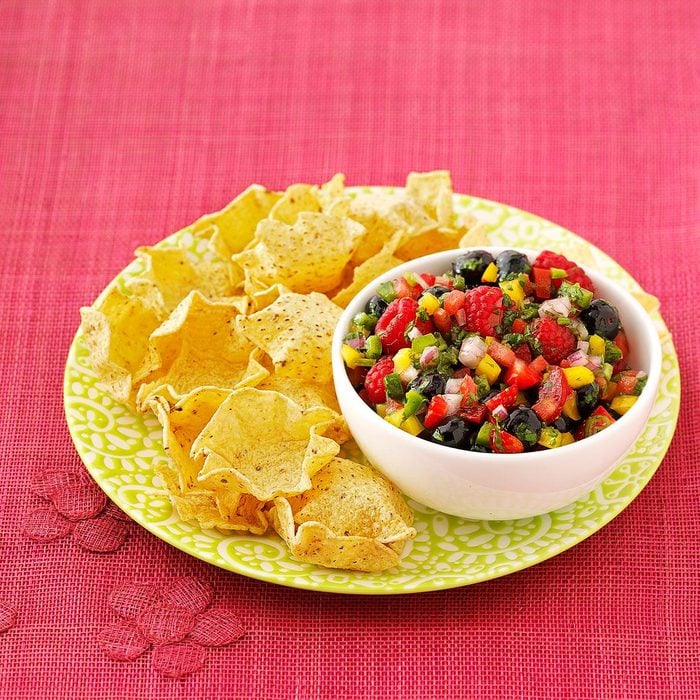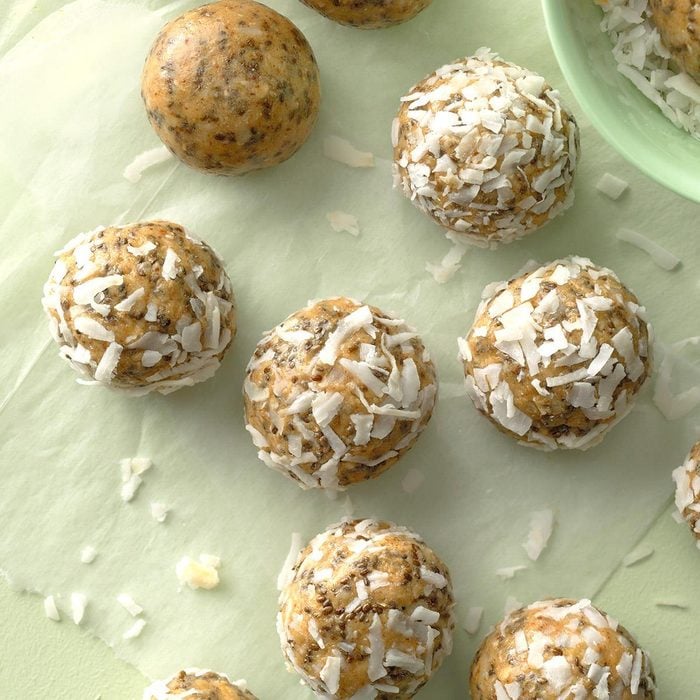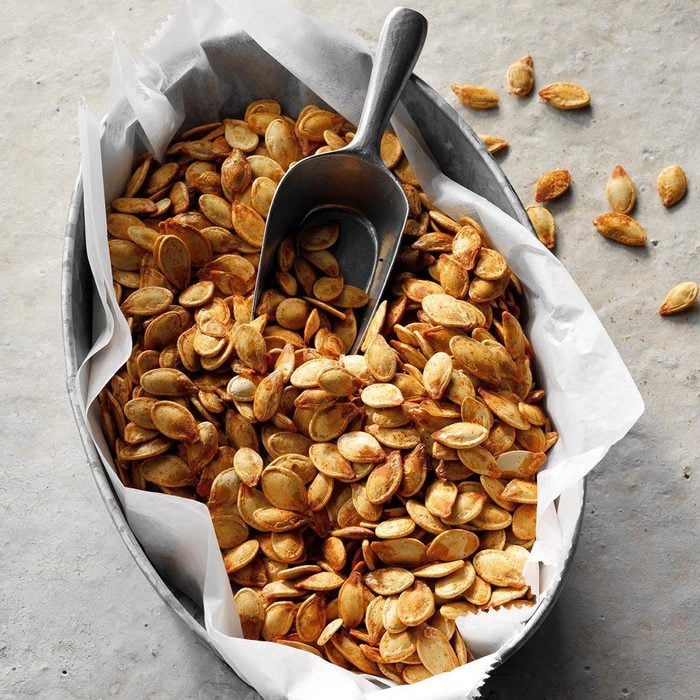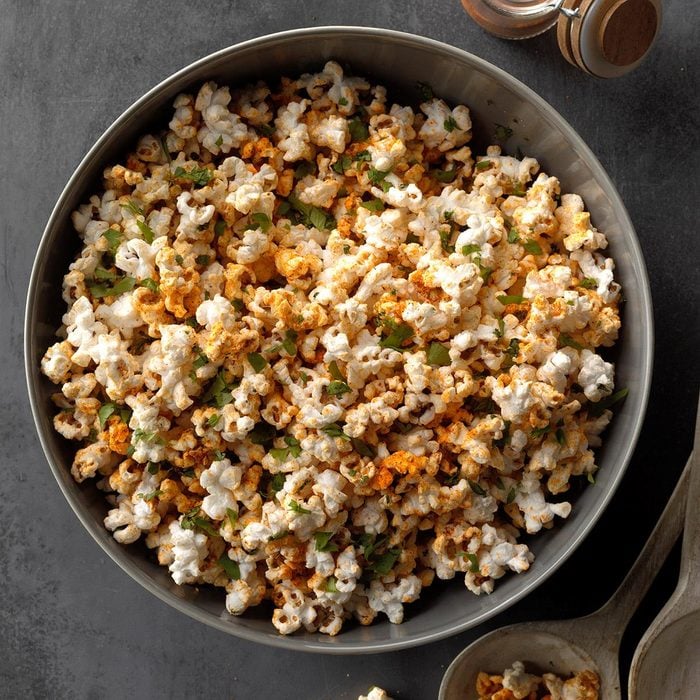Chili-Lime Roasted ChickpeasNutrition Facts
1/3 cup: 178 calories, 8g fat (1g saturated fat), 0 cholesterol, 463mg sodium, 23g carbohydrate (3g sugars, 6g fiber), 6g protein.
Crunchy. Spicy. Full of fiber. Packed with protein. Easy to make. These Chili-Lime Roasted Chickpeas might be everything you want and need in a snack! Plus, research suggests that chickpeas (along with other beans) might help <a href="https://www.ncbi.nlm.nih.gov/pmc/articles/PMC5188421/" target="_blank" rel="noopener noreferrer">prevent or reduce the progression of type 2 diabetes</a>.
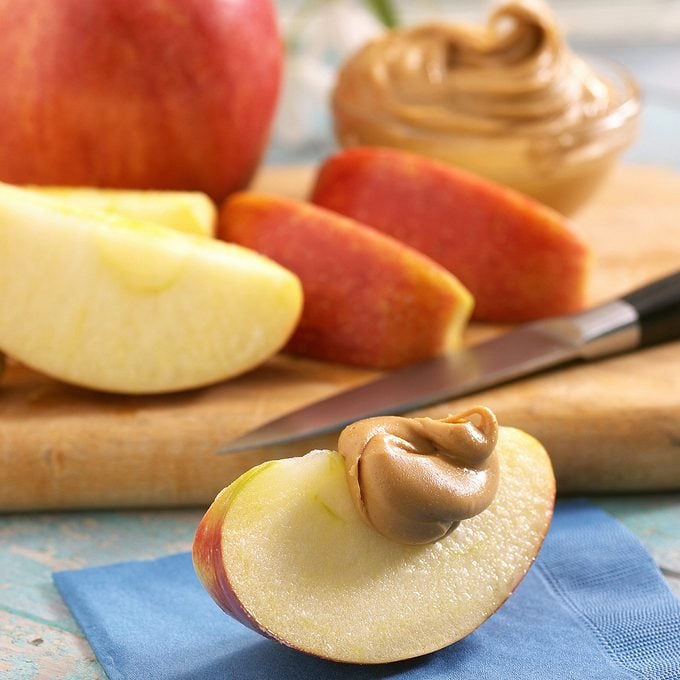 Lew Robertson/Getty Images
Lew Robertson/Getty ImagesApple with Peanut Butter
Nutrition Facts
1 medium apple: 94 calories, 0.3g fat (0g saturated fat), 0 cholesterol, 1.8mg sodium, 25g carbohydrate (19g sugars, 4g fiber), 0.5g protein.
2 tablespoons peanut butter: 188 calories, 16g fat (3g saturated fat), 0 cholesterol, 147mg sodium, 6g carbohydrate (3g sugars, 2g fiber), 8g protein.
A small apple with the skin and a couple tablespoons of peanut butter makes a fiber- and protein-rich snack. This classic combination provides a quick energy boost and a sweet and nutty treat any time of day. Slice up one small apple and spread one tablespoon of
homemade peanut butter on the pieces.
Horseradish Deviled EggsNutrition Facts
2 egg halves: 146 calories, 13g fat (3g saturated fat), 215mg cholesterol, 169mg sodium, 1g carbohydrate (1g sugars, 0 fiber), 6g protein.
Hard-boiled eggs are a handy high-protein and zero carb snack that won't increase blood sugars. Add horseradish and you've got a slightly spicy bite that's completely craveable. Make a batch for the week ahead! If you're insulin-dependent, add a slice of whole-grain toast or ten whole-grain crackers which will provide about 15 grams of complex carbs that offer perfect protection against your blood sugar going too low.
Caprese Salad KabobsNutrition Facts
1 kabob: 44 calories, 4g fat (1g saturated fat), 5mg cholesterol, 10mg sodium, 2g carbohydrate (1g sugars, 0 fiber), 1g protein.
With plenty of vegetables and healthy fats from olive oil, salad on a stick is an ideal nosh for people with diabetes. Make these ahead of time to keep in the fridge for a quick nibble between meals. The tomato and basil bring fresh flavor, while the mozzarella makes it satisfying. Since some balsamic vinegars have sugar added, double-check the ingredient label or make your own zero carb version such as this delicious <a href="https://www.tasteofhome.com/recipes/strawberry-basil-vinegar/">Strawberry-Basil Vinegar recipe</a>.
By the way, these are the best
salad dressings for people with diabetes.
Simple GuacamoleNutrition Facts
2 tablespoons: 53 calories, 5g fat (1g saturated fat), 0 cholesterol, 51mg sodium, 3g carbohydrate (0 sugars, 2g fiber), 1g protein.
This simple but filling guacamole can be savored with crunchy cucumber slices to keep carbs in check. This guac gets an extra hit of flavor from prepared salsa, making it even easier to pull together when you need it. Plus, the polyunsaturated fatty acids found in avocados are known to improve the function on insulin making it easier for the body to regulate blood sugar levels.
 PamelaJoeMcFarlane/Getty Images
PamelaJoeMcFarlane/Getty ImagesEdamame
Nutrition Facts
1 cup: 189 calories, 8.1g fat (1g saturated fat), 0 cholesterol, 9.3mg sodium, 15.8g carbohydrate (3.4g sugars, 8.1g fiber), 16.9g protein.
Cooked edamame provides roughly 17g protein and 8g fiber in one cup, which is why it's considered a powerful diabetes-friendly snack for keeping hunger levels in check. This diabetes-friendly munchable is available fresh or frozen, making it easy to season just as you'd like—try our
Spicy Edamame. Bonus: Bioactive compounds in these beans are also known to protect heart health in multiple ways such as lowering cholesterol and reducing blood pressure.
Cannellini Bean HummusNutrition Facts
2 tablespoons: 78 calories, 4g fat (1g saturated fat), 0 cholesterol, 114mg sodium, 8g carbohydrate (0 sugars, 2g fiber), 3g protein.
With creamy cannellini beans, tahini, garlic and lemon, this white bean dip has a Mediterranean flair and tons of taste. Dip crunchy carrots or cauliflower in for a fiber-rich <a href="https://www.tasteofhome.com/collection/healthier-recipes-to-snack-on-when-the-junk-food-cravings-hit/">healthy snack</a> that will easily keep you chugging along until your next meal. Make this diabetes-friendly dip even more beneficial by adding an extra dose of crushed garlic, which was shown in a meta-analysis to help reduce important markers of blood sugar control such as hemoglobin A1C levels.
Triple Berry SalsaNutrition Facts
1/4 cup (calculated without chips): 20 calories, 1g fat (0 saturated fat), 0 cholesterol, 28mg sodium, 3g carbohydrate (2g sugars, 1g fiber), 0 protein.
High in fiber, water and antioxidants, strawberries, blueberries and raspberries top the list of diabetes-friendly fruits. This salsa has all three, plus a hint of heat from jalapeno pepper. Snack on this sweet and tangy salsa solo or with crunchy endive or lettuce dippers. Pair it with delicious bean-based chips, which have more blood-stabilizing fiber and appetite-taming protein than traditional tortilla chips.
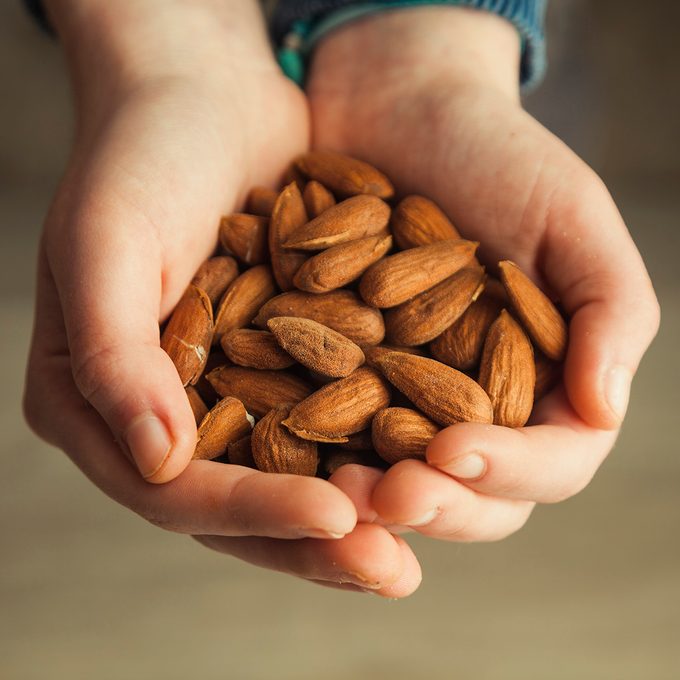 Maica/Getty Images
Maica/Getty ImagesAlmonds
Nutrition Facts
22 almonds: 171 calories, 15.6g fat (1.2g saturated fat), 0 cholesterol, 0.3mg sodium, 5g carbohydrate (1.3g sugars, 3g fiber), 6g protein.
Research suggests that a handful of almonds just might help keep blood sugars stable, thanks to the naturally present combination of fiber, protein and healthy fats. With a perfect crunch, this shelf-stable diabetes-friendly snack is ready whenever and wherever you are.
Chia Seed Protein BitesNutrition Facts
1 piece: 72 calories, 4g fat (1g saturated fat), 0 cholesterol, 14mg sodium, 9g carbohydrate (5g sugars, 2g fiber), 2g protein.
Chia seeds lend healthful fats, fiber and crunch to these energy bites making them a satisfying make-ahead snack. These delicious treats also pack nut butter, which means they're both filling and won't spike blood sugar. Roll these up for any time of day—especially before or after a workout. Chia seeds can add an appetite-taming upgrade to smoothies and yogurt too.
Spicy Pumpkin SeedsNutrition Facts
1/4 cup: 103 calories, 7g fat (1g saturated fat), 0 cholesterol, 158mg sodium, 9g carbohydrate (0 sugars, 1g fiber), 3g protein.
With 7 grams of protein per ounce, pumpkin seeds can help squash hunger in minutes. These seeds are also an ideal alternative if you have a nut allergy. Studies suggest that compounds in this festive snack can slow down the absorption of carbs in the gut helping to keep blood sugar balanced. Consider adding plain, shelled varieties to other dishes such as salads and baked goods. They're also high in magnesium, a mineral known to protect heart health.
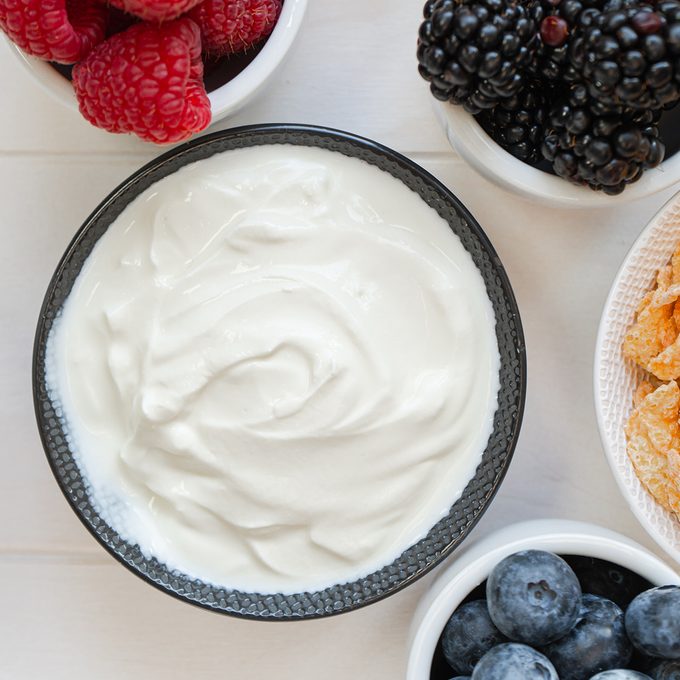 wilatlak villette/Getty Images
wilatlak villette/Getty ImagesGreek Yogurt
Nutrition Facts
6 ounces Fage Total 0%: 90 calories, 0g fat (0g saturated fat), 10mg cholesterol, 65mg sodium, 5g carbohydrate (5 sugars, 0g fiber), 18g protein.
With twice the protein of the regular variety, Greek yogurt has more staying power to keep you feeling full longer which could help with weight management and balancing blood sugar. Yogurt also provides a good boost of calcium plus vitamin D, a combination thought to help optimize blood sugar control. Sweeten up yogurt naturally with fresh berries, make it savory with a swirl of pesto or add nuts for crunch.
Tex-Mex PopcornNutrition Facts
1 cup: 44 calories, 3g fat (0 saturated fat), 0 cholesterol, 150mg sodium, 5g carbohydrate (0 sugars, 1g fiber), 1g protein.
If you tend to want lots of volume in a snack, popcorn is the perfect pick. A whopping three cups make the typical serving and popcorn is a blank canvas to dress with your favorite seasonings. This Tex-Mex variety turns up the heat. You can also try Parmesan cheese, or a mixture of Romano cheese, basil and oregano. Since popcorn is a complex carbohydrate that contains fiber, it won't ratchet up blood sugar the way other high carb snack foods do.
Fiesta Shrimp CocktailNutrition Facts
1 cocktail: 134 calories, 5g fat (1g saturated fat), 115mg cholesterol, 359mg sodium, 6g carbohydrate (3g sugars, 1g fiber), 16g protein.
You might feel a little fancy eating this for a snack, but this spin on shrimp cocktail is a delectable appetizer that can be made for one or many. Packed with protein and a hint of peppery spice, it's a smart choice for people with diabetes. Consider pairing it with whole-grain crackers to add some crunch and an extra dose of fiber.
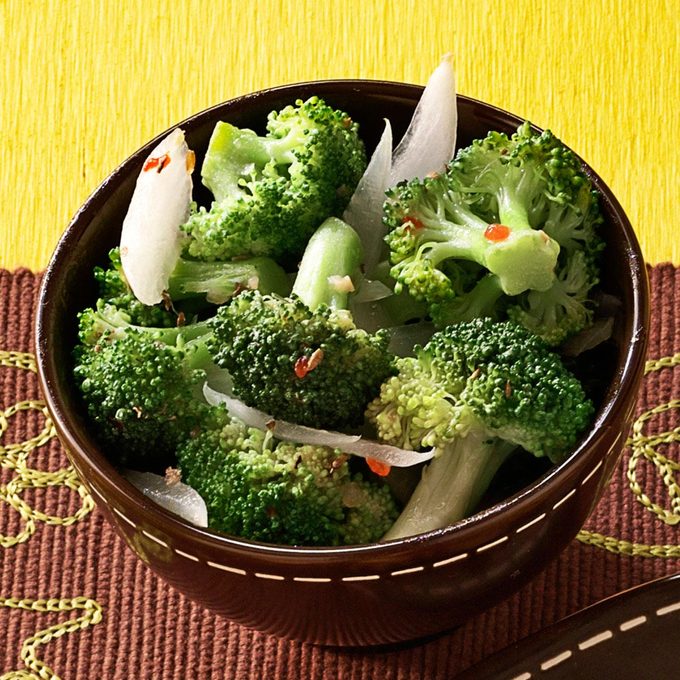 Taste of Home
Taste of HomeRaw or Cooked Vegetables
Nutrition Facts
100 g cooked broccoli: 35 calories, 0.4g fat (0.1g saturated fat), 0mg cholesterol, 41mg sodium, 7.2g carbohydrate (1.4g sugars, 3.3g fiber), 2.4g protein.
Fresh broccoli, cauliflower or even dill
pickles make a crunchy snack with or without
hummus or other dips. Get creative—add vegetables to skewers with a drizzle of vinaigrette. Remember, any non-starchy vegetable can easily be
roasted to make an easy-to-eat snack, too.
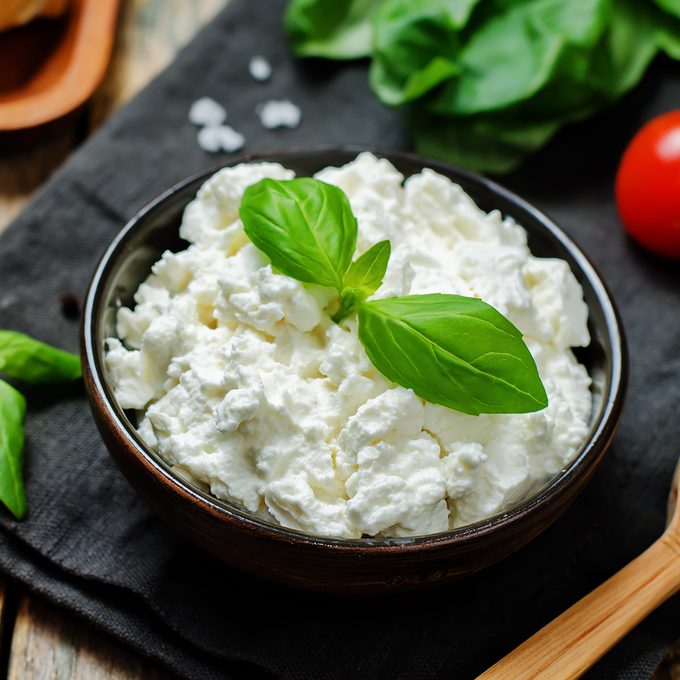 nata_vkusidey/Getty Images
nata_vkusidey/Getty ImagesRicotta Cheese
Nutrition Facts
1/2 cup whole milk ricotta: 216 calories, 16.1g fat (10.3g saturated fat), 63.2mg cholesterol, 104mg sodium, 3.8g carbohydrate (0.3g sugars, 0g fiber), 14g protein.
Spoon a large dollop of this creamy, comforting cheese into a bowl, sprinkle with cinnamon and a dash of vanilla extract, then stir for an easy-to-make and satisfying dessert-like snack that's both high in protein and calcium. If your hunger is really high, make it even more filling by topping with some slivered almonds, which are known to help keep blood sugar down even after a meal.






















